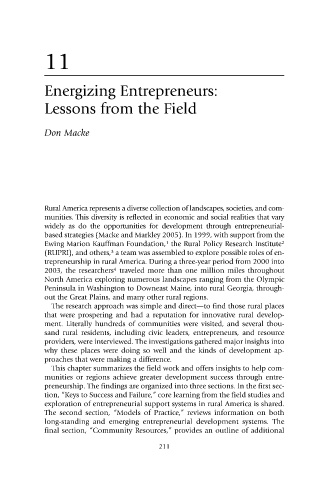Page 222 - 1-Entrepreneurship and Local Economic Development by Norman Walzer (z-lib.org)
P. 222
11
Energizing Entrepreneurs:
Lessons from the Field
Don Macke
Rural America represents a diverse collection of landscapes, societies, and com-
munities. This diversity is reflected in economic and social realities that vary
widely as do the opportunities for development through entrepreneurial-
based strategies (Macke and Markley 2005). In 1999, with support from the
1
Ewing Marion Kauffman Foundation, the Rural Policy Research Institute 2
3
(RUPRI), and others, a team was assembled to explore possible roles of en-
trepreneurship in rural America. During a three-year period from 2000 into
4
2003, the researchers traveled more than one million miles throughout
North America exploring numerous landscapes ranging from the Olympic
Peninsula in Washington to Downeast Maine, into rural Georgia, through-
out the Great Plains, and many other rural regions.
The research approach was simple and direct—to find those rural places
that were prospering and had a reputation for innovative rural develop-
ment. Literally hundreds of communities were visited, and several thou-
sand rural residents, including civic leaders, entrepreneurs, and resource
providers, were interviewed. The investigations gathered major insights into
why these places were doing so well and the kinds of development ap-
proaches that were making a difference.
This chapter summarizes the field work and offers insights to help com-
munities or regions achieve greater development success through entre-
preneurship. The findings are organized into three sections. In the first sec-
tion, “Keys to Success and Failure,” core learning from the field studies and
exploration of entrepreneurial support systems in rural America is shared.
The second section, “Models of Practice,” reviews information on both
long-standing and emerging entrepreneurial development systems. The
final section, “Community Resources,” provides an outline of additional
211

